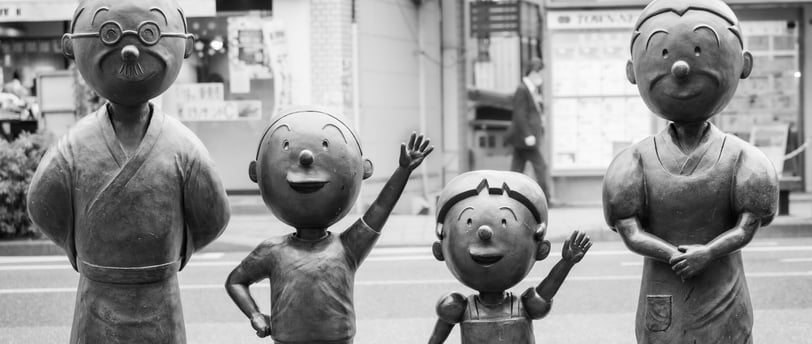Understanding America
The Best Breakdown of America You’ve Never Heard - Richard Miniter
Dennis Price
5/29/20256 min read


The Best Breakdown of America You’ve Never Heard - Richard Miniter Metadata Date: May 26, 2025
Channel: Triggernometry
Introduction: America as Four Religious Utopias
Richard Miniter presents a compelling thesis that fundamentally reframes how we understand American culture and politics. According to his analysis, America was founded not as a single unified nation, but as four separate, somewhat coercive religious utopias that originated from different periods in British history. These distinct cultural foundations continue to shape American society today, creating internal tensions that manifest in contemporary political divisions.
The key to understanding America, Miniter argues, lies in comprehending Britain's past, particularly the English Civil War. The cultural shadows of these historical events remain alive in America while being largely forgotten in Britain itself. As he puts it, "We are your past" - America preserves and continues to live out cultural conflicts that Britain has moved beyond.
The English Civil War's American Legacy The English Civil War serves as the foundational event that explains America's cultural divisions. After Henry VIII transformed Britain into a Protestant country, tensions arose between different religious factions. The Puritans, suspicious that the crown harbored Catholic leanings and wanted to return England to Rome, developed a culture of suspicion and paranoia that ultimately led to armed conflict.
The war pitted Parliament, dominated by urban dwellers and Puritans, against the king and his supporters, known as cavaliers, who were rural, traditional, and resistant to major changes in their faith. The Puritans, also called Roundheads due to their distinctive hats, were young, ideological men who were certain of their beliefs, intolerant of dissent, and willing to use political violence to advance their views.
The conflict's intensity is illustrated by incidents where Roundheads would attack bishops traveling by boat on the Thames to prevent them from voting in the House of Lords in favor of the king. The war culminated in the unprecedented execution of the king, who delivered a famous scaffold speech pleading for individual liberty. This speech was required reading in American southern public schools until the 1960s, demonstrating the lasting cultural impact of these events.
The Four American Cultures New England:
The Puritan Legacy
New England, encompassing Massachusetts, Connecticut, Rhode Island, New Hampshire, Maine, and parts of upstate New York, was settled primarily by Puritans from East Anglia - the region of England that juts into the English Channel toward the Netherlands. These settlers brought with them a legalistic, often arrogant worldview that emphasized the freedom to impose virtue on society.
The Puritan influence manifested in various ways, including the infamous witch trials. Approximately 350 people were accused of witchcraft in the American colonies, with almost all cases occurring in New England. This mirrors the pattern in England, where witch trials during this period were concentrated in East Anglia, the very region from which these settlers originated.
The South: Cavalier Culture
Virginia, Maryland's shores, the Carolinas, parts of Georgia, and Kentucky were settled by people from southwestern England who had supported the losing side of the English Civil War. These settlers favored the crown, believed in social hierarchy, and established a plantation system initially based on indentured servitude of Welsh and Irish people. When this labor source proved insufficient, they turned to African slavery imported through the Caribbean.
This culture, while possessing some admirable elements, also contained profoundly evil aspects, particularly its embrace of human bondage. The cavalier tradition emphasized the freedom to maintain social hierarchy and established order, creating a stark contrast with Puritan ideals.
The Middle States:
Commercial Freedom The middle states - New York, Pennsylvania, Delaware, and New Jersey - were settled by people from England's west midlands and areas near the Scottish border. These settlers brought a different conception of freedom: the liberty to make money and conduct commerce with minimal interference, provided there was sufficient law and order to prevent corruption and theft in financial markets.
Appalachia: The Freedom to Be Left Alone The Appalachian Mountains, running from Maine to Georgia, were settled by people from the English side of the Scottish border. Their conception of freedom differed markedly from the other three cultures - they simply wanted to be left alone. However, this libertarian impulse came with significant drawbacks, including deep opposition to education, particularly for women.
Cultural Networks and Immigration Patterns
Miniter emphasizes a crucial point about immigration: there is no such thing as simple migration from one country to another. Instead, social networks move, carrying with them the ideas and customs of their original villages. These transplanted social networks then recreate their original cultural patterns in their new settlements, which become the inherited culture of subsequent generations.
This process explains why the ideas and conflicts of 17th-century English villages continue to influence American politics centuries later. The cultural DNA of these original settlements has been preserved and transmitted through families and social networks across generations.
Modern Political Implications Trump's Electoral Success
Trump's political success can be understood through this cultural lens. He managed to assemble three of the four cultural traditions: the proto-libertarian Appalachian culture (which values being left alone), the hierarchical cavalier tradition (despite Trump's elite background), and elements of the middle states' commercial culture. His support is weakest in areas settled by New England Puritans - Massachusetts, California (settled by northeasterners), and the Pacific Northwest.
The COVID-19 pandemic served as a watershed moment for the libertarian-minded culture, as government restrictions on movement, work, worship, and commerce violated their fundamental belief in being left alone. This helped solidify their support for Trump's anti-establishment message.
The Accountable vs. Unaccountable Divide
Miniter identifies a crucial modern division between what he calls the "accountable" and "unaccountable" classes. The accountable class includes people whose pay is tied to specific results - salespeople earning commissions, teachers evaluated on student outcomes, entrepreneurs whose success depends on market performance. The unaccountable class includes those paid simply for showing up, regardless of results.
This division cuts across traditional political lines and helps explain the appeal of figures like Elon Musk, who represents the frustration of the accountable class with government inefficiency. Musk's complaints about having to fax forms to the FAA for rocket launches exemplify this frustration with bureaucratic obsolescence.
Religious Resurgence and Cultural Change
America is experiencing a notable religious resurgence, particularly among young people attracted to traditional forms of Christianity, including the Latin Mass, Orthodox Christianity, and traditional Anglicanism. This trend was accelerated by COVID-19, which forced many young people to confront mortality and seek certainty in an uncertain world.
The appeal of traditional religion lies partly in its clear answers and demands for personal transformation. Unlike liberal faiths that impose fewer requirements, traditional Christianity attracts people seeking structure and meaning. This religious revival has political implications, as it strengthens the cultural foundations that support conservative politics.
The Role of Social Isolation and Masculinity Modern
America faces unprecedented levels of social loneliness, particularly among young men who lack clear pathways to adulthood. Many grew up in single-parent homes and struggle to understand how to become men without traditional cultural touchstones. This has led them to seek very traditional answers, largely because these are the only coherent models available.
The absence of a "female Jordan Peterson" suggests that this crisis of meaning and identity may be particularly acute for young men, though young women also face challenges related to social media-driven competition and unrealistic expectations.
The Future of American Politics Republican Consensus vs. Democratic Coalition
Miniter argues that the Republican Party operates as a consensus party, where internal fights serve to adjust and refine the party's direction rather than threaten its unity. This contrasts with the Democratic Party, which functions as a coalition party requiring constant management of competing interests.
The Republican consensus model appears to be working, as evidenced by the party's ability to attract new voters across racial and ethnic lines. Hispanic voters, in particular, shifted significantly toward Trump, largely because many work in the accountable economy and resent crime, high taxes, and regulations that affect their small businesses.
Democratic Party Challenges
The Democratic Party faces severe structural challenges. Their dominance by campus-based intellectuals has created a disconnect with the broader population, three-quarters of whom lack four-year college degrees. The party's embrace of identity politics and dismissive attitude toward working-class concerns has alienated key constituencies.
The party's paternalistic approach to Black voters, in particular, fails to recognize the reality of modern African-American life, which includes significant interracial marriage, entrepreneurial success, and middle-class achievement. This outdated perspective treats contemporary Black Americans as if they were still living in 1965.
Cultural Power Shifts
The balance of power among America's four cultures continues to evolve. Currently, Florida and Texas are attracting the most internal migrants, suggesting a shift toward the cavalier tradition. The cultural power of Puritan New England has declined significantly, despite the continued presence of elite universities in the region.
The middle states and rust belt remain crucial in determining close elections, containing three of the four major swing states. However, these regions appear to be trending rightward as they recover from industrial decline and embrace innovation.
Conclusion:
America's Enduring Cultural Divisions Miniter's analysis reveals that America's political divisions run far deeper than contemporary policy disagreements. They reflect fundamental differences in how various cultural traditions understand the relationship between citizen and state, individual and community, and temporal and spiritual authority.
These divisions, rooted in 17th-century English conflicts, continue to shape American politics because they were embedded in the social networks and cultural patterns of the original settlers. Understanding this deeper cultural foundation is essential for comprehending why Americans often seem mysterious to Europeans and why American political conflicts can appear so intractable.
The ongoing tension between these four cultural traditions - Puritan, Cavalier, Middle States commercial, and Appalachian libertarian - ensures that America will continue to be, in Miniter's words, "at odds with itself." This internal tension, while sometimes destructive, also provides the dynamic energy that has driven American innovation and adaptation throughout its history.
